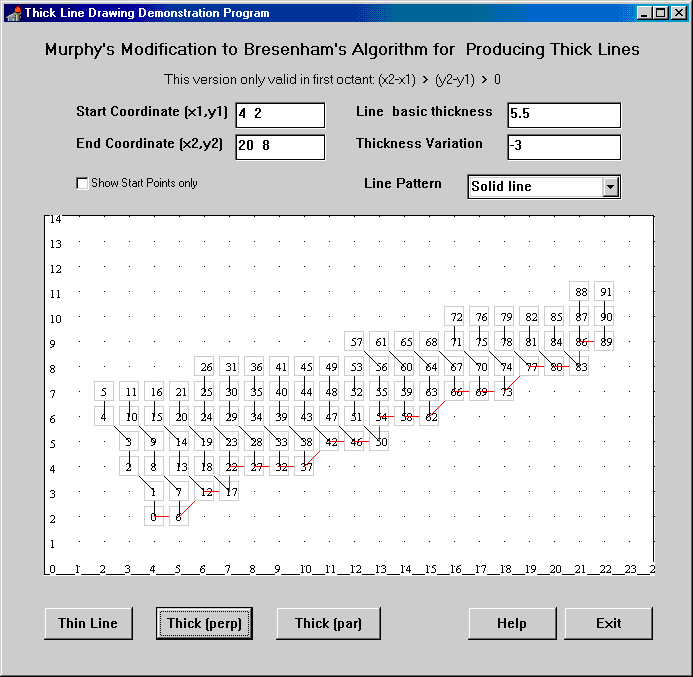Murphy's Modified Bresenham Line Drawing Algorithm
An Algorithm for drawing thickened lines
Background
This page describes an algorithm for drawing thickened lines on a display
or picture grid.
It is based on an extension to Bresenham's Line drawing algorithm - see:
"J. E. Bresenham, IBM Systems Journal 4, 25-30 (1965)".
The modified algorithm was first published as
'Line Thickening by Modification to Bresenham's Algorithm'
in the IBM Technical Disclosure Bulletin
Vol.20 No.12 May 1978 pages 5358-5366.
This is copyright IBM Corporation 1978, but
IBM have kindly granted their permission for me to reproduce the article here
(each page about 20K):
Page 1
Page 2
Page 3
Page 4
Page 5
Page 6
Page 7
Page 8
Page 9
All pages in a ZIP file of GIFs (182K)
Advantages of the Algorithm
- Each pixel, which is set, is visited only ONCE - this makes
the algorithm very suitable for use in XOR situations (for exampe,
when pixels are XORed onto other images).
- The inner loop and most of the outer loop require only addition,
and comparision testing. This produces an efficient algorithm.
- The line thickness can be a real number, is is not necessary to
be an integer.
- The perceived line thickness does not vary for lines of
different orientations.
- It is possible to have a thickness which is a function of the
distance from the start point - the thickness varies along the
line, giving the possibility of depth-cueing (Z-axis effects).
General Principle
In order to draw a thick line, you need to draw a number of parallel
single thickness lines. There are 2 ways to do this:
- Draw lines perpendicular to the ideal line stepping along it.
- Draw lines parallel to the ideal line and step perpendicularly.
The document describes algorithms for each of the above situations.
Both algorithms have two Bresehham loops, one inside
the other. The outer loop does the 'stepping' and the inner loop draws
single pixel lines.
The key aspect of the technique is that the outer loop contains just
the right information for the inner loop. This is important as the
inner loop must be started in the 'correct' phase of its cycle so that
the diagonal moves occur in phase. The outer loop's difference terms are
passed to the inner loop to accomplish this.
Another aspect of the
technique is that an 'extra' inner loop cycle is required whenever the outer
loop and the inner loop do a diagonal move together. In this case the
outer loop does a 'double square' move rather than a diagonal move.
When the outer loop detects this condition it performs a square move,
calls the inner loop, does
another square move at right angles and calls the inner loop again.
In this way a diagonal move is achieved but there are two calls to the
inner loop.
Demonstration Program
The original paper is not particularly clear. However, I have produced a
thick line drawing demonstration program
which better illustrates the technique (115K approx). This is an
Object Pascal Delphi 1 program complete with source code.
I have rushed the programming and so the demo is NOT well tested.
Please be careful if you run it by saving all important data in other
programs first. Because the loop end conditions are tricky to get right,
it is just possible that the demo may get into an infinite loop.
This version of the demo only supports the drawing of lines in the
first octant - where (X2-X1)>(Y2-Y1)>0.
Drawing lines in other octants is obtained by defining the 4 types of
moves required by the loops.
I hope to illustrate this in a future version of the demo. Also the
thick line is drawn to one side of the ideal line. This will be
corrected in a future version.
Variations
The demo program illustrates one method by which line patterns may be formed.
In this case the pattern is a function of (p,q) and so the pattern is with
respect to the line orientation. An alternative is to make the pattern a
function pt.x and pt.y - this produces slightly nicer looking patterns.
The line thickness variation is illustrated using the 'thickfunct' which
shows how the thickness can be varied along the length of the line. This
uses the Thick(Perp) algorithm.
Screen Shot
The following is a screen shot of the demonstration program:

This shows a line drawn from (4 2) to (20 8) with a line thickness of 5.5
and a reducing taper of -3, using the Thick(perp) algorithm.
It shows the sequence order in which the pixels
are drawn (0,1,2,3.....).
Note that between line y=5 and y=6 all perpendicular lines execute the
diagonal move 'in phase' with each other.
The start points for the perpendicular lines are
0,6,12,17,22,27,32,37,42,46...... Note that the pixel labelled 22
is 'extra' to Bresnemham's original algorithm in that it is produced
by a double square move rather than a diagonal move between
pixels labelled 17 and 27. This extra line is required because the outer
loop executes a diagonal move whilst the inner loop does so as well
(between lines y=5 and y=6). This extra pixel produces the perpendicular
line (pixels 22-26).
Warning
Because the demo program is NOT well tested, the author accepts
no responsibility for the operation of the algorithm in its current
state.
Contacting me
Please send any comments to me:
Alan Murphy
E-mail me at:
murphy@enterprise.net
Other Places to visit
| Murphy Homepage |
GPS Utility Program |

